MOTORCYCLING: CORNERING A MYTH
"For the spirit of the living creatures was in the wheels"
Old Testament (Ezekiel I, 20)
"Power and machines, money and goods are only useful if they help to make you independent"
Henry Ford
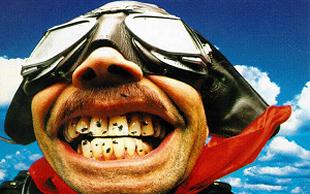
"For the spirit of the living creatures was in the wheels"
Old Testament (Ezekiel I, 20)
"Power and machines, money and goods are only useful if they help to make you independent"
Henry Ford

Motorcycle experts, road philosophers and petrol-head romantics have
written tomes about motorcycles and their inexplicable effect on people. While we may never
be able to get completely to the bottom of the secret of these mechanical objects of desire,
I think it is nonetheless worthwhile searching for "the truth", while trying as
far as possible to avoid the countless "biker" clichés rammed down our
throats by the mass media. This iron horse is Janus-faced, on the one hand pure determinism
and mere machine (but one that is revered and adored as though subject of some cult), but on
the other hand the symbol and the epitome of freedom. I would like to approach this 20th
Century "steed" from various points of view, in order to corner the myth, and
try thereby to get on the trail of the remarkable phenomenon that motorcycling has become.
Thank God tastes differ or - shock, horror - we'd all be riding Harley
clones! Well, OK, even though we all have different tastes, it does seem that a motorcycle's
appearance is one of the essential features of the machine as an overall work of art.
Indeed, for many demented hedonists, the motorcycle serves as sort of mobile steel and
plastic sculpture. And just as sculpture has its immortal works (you only have to think of
Michelangelo's "David" or Rodin's "Thinker"),
With the compact engine tucked into its gut inside the bike's triangular frame, this is an
old two-wheeler big on power. The mudguards gently bending into each other form a larger
triangle, in which the rider sits, part of the engineer's design. Man, the pilot, is right
in the middle of this "chapel of iron, aluminium, glass, chrome and rubber".
Inspired beauty, Greek proportions, a work of art on two wheels - that is the BMW R32!
The vehicle's gentle silhouette and restrained colours are part of the design magic. Mainly
black with white pin stripes, and with the BMW emblem as the only splash of colour. The
bright metal handlebars and the brown leather saddle gleam like Kimberley diamonds, lighting
up where man has his contact with it, possesses and controls it. For me, the R32 ranks as
one of the most beautiful machines in the world.
Some of my more intellectual friends would tell me that amazement is
at the bottom of all philosophy.
Nothing has marked this century more than the discovery of speed as
part of life. The Italian Marinetti, founder of the 20th Century revolt against tradition,
once lauded speed as follows: "Bicycles and motorbikes are divine. Petrol is divine. The
religious ecstasy of the 100 horsepower engine. The joy of changing up from third to fourth.
The thrill of turning on the power. Revving up speed as though conducting an orchestra.
Every night I pray to my light bulbs, as they embody the greatest speed of all"
(quoted by M. Holfelder **).
In contrast to the car, on a motorbike the sensual dimension of speed is always there. No
crumple zone at all means not only the higher the speed the greater the danger, but also
that there is a direct effect on the way the rider behaves. He has to sway with the curves,
he must react and live with the surface of the road, and he must anticipate what is important
and do the right thing. On the straight, the strength of the headwind tells you how fast you
are really going. Uneven surfaces, changes in direction, weather conditions, here you get to
grips with the real world, as part of it, not just observing it as an opponent, alienated
from nature and the environment. You seem to grow into the asphalt itself, to become part
of this artery of traffic, your speed taking you out of the present and away from the
transitory to an endorphin high in your own private world.
Danger does of course go hand in hand with speed. Hellmut Walters'
judgement on modern roads brings that point sharply into focus: "Nothing but blood can
flow down arterial roads". But the flip side of freedom when motorcycling does not
have to be accident, or even death. The risks are known and the dangers ever present.
Amongst them are too little experience, the unpredictable behaviour of many car drivers,
hazards on the road (patches of oil, potholes, the elements, and sudden obstacles), and
technical problems with the bike. You only avoid these in the long term by adopting a clever
and reactive style of driving. Only a style of riding that builds in reaction times can
help avoid accidents arising from such road hazards. There is just no way that risk to life
should be seen as the price for freedom and adventure. Whoever may have coined the saying
"no risk, no fun" could not have had any basis for it from the way bikers actually
behave.
The brother of Austria's Nobel prize-winner Konrad Lorenz writes of
his motorbike in his memoirs of the time before the First World War: "My Laurin &
Clement ran as sweet as a bell,
Bikers are generally gregarious beings, and enjoy each other's company.
Central Europe alone sees hundreds of biker's get-togethers, occasions of all sorts of sizes.
But then it's back to the loneliness of the road. Away from the campfires of the gatherings,
just you and your bike together again. Many bikers are rugged individualists, revelling in
the freedom of solitariness. Just to be out there, in unfamiliar territory, often leads to
a mood of meditation, of contemplation of life generally, and of introspection. So the real
biker gets his adrenaline both from solitude and from the fun of company. This goes a little
way towards explaining why there are so many happy bikers.
Contrary to ordinary life, wherein so much energy has to be expended
to overcome everyday problems, in motorcycling you find yourself higher up on a different
level, away from reality, dominating power and having the feeling of being master of your
destiny.
This unity of man and machine pushes them on to physical limits, until it cracks suddenly
and ends abruptly, sometimes fatally. A motorcycle is not supposed to be a vehicle for
delineating physical limits, the myth reveals itself much more as this fine line between
external speed and inner peace. There are motorcyclists who do not understand this law and
play with their own lives. Often they are young and inexperienced, certainly not always,
but they are still stupid. Then there are others, who dance with death. They are all too
aware of their own mortality, and take the consequences. For them speed is the focus of
life - everything they see is focused by speed. They don't seek out risk, they take it in
their stride. The greatest speed demands the greatest inner peace, and he who fails to
concentrate on the vanishing point ahead, who does not heed the flickering flames of the
world around him, who cannot switch his concentration back and forth from outer to inner,
he will never come to understand the soul of biking.
"Paradoxically, four wheels are only half the truth"
"Paradoxically, four wheels are only half the truth"
"Rubber side down!"
** : Literature: Moritz Holfelder, "Das Buch vom Motorrad", published by Husum
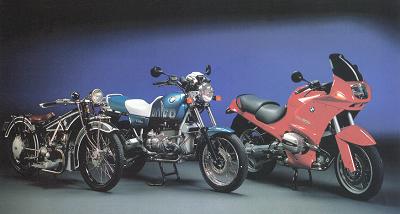 so the history of the
motorcycle has produced a wealth of immortal creations - the 1922 Megola Sport, the 1948
Indian Chief, the 1994 Ducati 916 and the latest MV Augusta F4-750 to name but four. Just
consider these points about one of the most beautiful specimens, the BMW R32, built in Munich
at the beginning of the 1920's by Max Friz. Technically speaking it represents a milestone in
the development of the motorcycle. Its shaft-drive and flat-twin boxer engine stand their
ground even today, and the proportions of the vehicle are perfection. The starting point of
this motorcycle was a mathematical "golden section" - a sort of organic whole with
everything in just the right place. In short - a touch of genius, and a thread that still
runs through every BMW motorcycle. From my perspective that same manufacturer has missed
the mark with their cold, clinical, sterile and characterless cars. However, their
motorcycles remain classics, rooted in the immortal R32.
so the history of the
motorcycle has produced a wealth of immortal creations - the 1922 Megola Sport, the 1948
Indian Chief, the 1994 Ducati 916 and the latest MV Augusta F4-750 to name but four. Just
consider these points about one of the most beautiful specimens, the BMW R32, built in Munich
at the beginning of the 1920's by Max Friz. Technically speaking it represents a milestone in
the development of the motorcycle. Its shaft-drive and flat-twin boxer engine stand their
ground even today, and the proportions of the vehicle are perfection. The starting point of
this motorcycle was a mathematical "golden section" - a sort of organic whole with
everything in just the right place. In short - a touch of genius, and a thread that still
runs through every BMW motorcycle. From my perspective that same manufacturer has missed
the mark with their cold, clinical, sterile and characterless cars. However, their
motorcycles remain classics, rooted in the immortal R32.
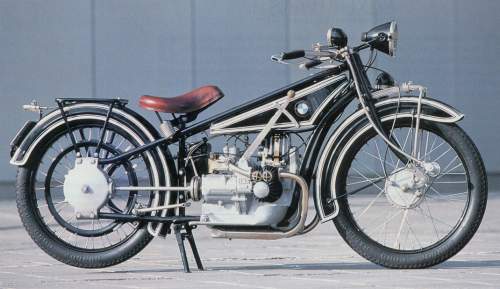
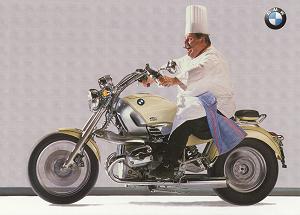 But let's face it, amazement is a thoroughly childlike
virtue. It requires you to be able to lose yourself in the world; to become at one with
objects, bound up with them by amazement, closely followed by sheer joy. I call this the
"Ferrari Syndrome"! This is exactly what happens to real bike fans�of both genders
afflicted by the "Ferrari Syndrome"! You regain your youth, ogle the vehicle like
a small child, and lose yourself in the world of speed and joy. It's interesting that the
old cliché of the "child inside the man" emerges, like a chrysalis, as not
being too far from the truth after all. Perhaps there's some kind of inherited gene having
its effect on us here. Even the smallest of babies stop fretting if picked up and comforted.
It's exactly the same with the motorbike enthusiast. As soon as the motor is kicked into
life and the unmistakable throb of the engine can be heard, the motorcyclist is happy -
really at peace with himself. That's undoubtedly when bikers become "nomads,
impervious to time".
But let's face it, amazement is a thoroughly childlike
virtue. It requires you to be able to lose yourself in the world; to become at one with
objects, bound up with them by amazement, closely followed by sheer joy. I call this the
"Ferrari Syndrome"! This is exactly what happens to real bike fans�of both genders
afflicted by the "Ferrari Syndrome"! You regain your youth, ogle the vehicle like
a small child, and lose yourself in the world of speed and joy. It's interesting that the
old cliché of the "child inside the man" emerges, like a chrysalis, as not
being too far from the truth after all. Perhaps there's some kind of inherited gene having
its effect on us here. Even the smallest of babies stop fretting if picked up and comforted.
It's exactly the same with the motorbike enthusiast. As soon as the motor is kicked into
life and the unmistakable throb of the engine can be heard, the motorcyclist is happy -
really at peace with himself. That's undoubtedly when bikers become "nomads,
impervious to time".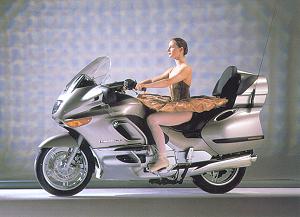 The reputation of motorcyclists and their love of speed is
rather less than flattering. The cliché of the aggressive biker wanting to leave everything
and everybody behind him may apply in individual cases, but for the majority of riders it
is actually rather wide of the mark. For them the road is not a racing track. They get their
kicks from the noise of the engine, from just going along, hugging the curves. They savour
the fine line between total concentration and letting their thoughts wander, the literally
simultaneous ups and down of the landscape, and the speed that compels them to process, in
a short space of time, an enormous amount of information.
The reputation of motorcyclists and their love of speed is
rather less than flattering. The cliché of the aggressive biker wanting to leave everything
and everybody behind him may apply in individual cases, but for the majority of riders it
is actually rather wide of the mark. For them the road is not a racing track. They get their
kicks from the noise of the engine, from just going along, hugging the curves. They savour
the fine line between total concentration and letting their thoughts wander, the literally
simultaneous ups and down of the landscape, and the speed that compels them to process, in
a short space of time, an enormous amount of information.
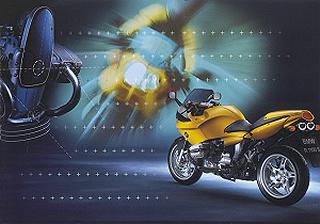 which was astonishing considering its construction was
really unspeakably primitive. The engine had a surface carburettor, i.e. a simple reservoir
from which the petrol vaporised into an induction pipe, where another shutter valve
regulated the admission of air. The more it was shaken about, the better the carburation.
So to start up on cold mornings those in the know would zoom around on bumpy driveways,
until the engine had warmed up. On really cold days you simply poured boiling water into
the petrol, to warm it up!" (Quoted by Holfelder **) Today's motorcycles are ingenious
hi-tech products that incorporate state of the art technology. The old aura of improvisation
and adventure is nevertheless still there. The technical spec of a 750 cc machine today
runs, in an MV Augusta for example, like this: 750 cc 4-stroke cycle, four cylinders in a
row, bore/piston stroke: 73.8/43.8 mm 16 radially ordered valves, 12.1 compression, six
gears, 180kg, 126 horse-power at the crank shaft, maximum torque of 72 Nm/9000: speed -
275 km/h.
which was astonishing considering its construction was
really unspeakably primitive. The engine had a surface carburettor, i.e. a simple reservoir
from which the petrol vaporised into an induction pipe, where another shutter valve
regulated the admission of air. The more it was shaken about, the better the carburation.
So to start up on cold mornings those in the know would zoom around on bumpy driveways,
until the engine had warmed up. On really cold days you simply poured boiling water into
the petrol, to warm it up!" (Quoted by Holfelder **) Today's motorcycles are ingenious
hi-tech products that incorporate state of the art technology. The old aura of improvisation
and adventure is nevertheless still there. The technical spec of a 750 cc machine today
runs, in an MV Augusta for example, like this: 750 cc 4-stroke cycle, four cylinders in a
row, bore/piston stroke: 73.8/43.8 mm 16 radially ordered valves, 12.1 compression, six
gears, 180kg, 126 horse-power at the crank shaft, maximum torque of 72 Nm/9000: speed -
275 km/h.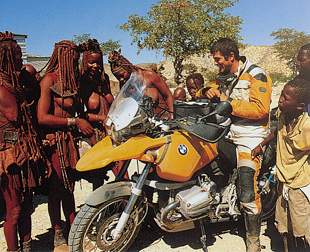 The wilder and the more provocative such gatherings the better. Lots of booze is the obvious
antidote to their fast life-styles. You can't race all day, so at some point you just land up
somewhere, tired and tipsy with your soul mates. Not, however, before you have had a good
dose of togetherness and solidarity, swapped the latest on specs, checked the market for
second-hand spares, or taken your turn on one of the many attractions of the whole programme.
The wilder and the more provocative such gatherings the better. Lots of booze is the obvious
antidote to their fast life-styles. You can't race all day, so at some point you just land up
somewhere, tired and tipsy with your soul mates. Not, however, before you have had a good
dose of togetherness and solidarity, swapped the latest on specs, checked the market for
second-hand spares, or taken your turn on one of the many attractions of the whole programme.
 The motorcycle is now what the horse used to be for centuries. Putting it casually, the
history of locomotion runs from the horse, past the steam "steed" through to the
motorcycle. So it is not surprising that in Sergio Leone's film "Melody of Death"
a motorcycle cowboy cleans up the Wild West. But a horse is a living creature, having its
own character and life arising from its proximity to man and its capacity to be trained. The
motorcycle is however completely subject to man's will, it represents the powerful extension
of his imagination, of his longing, of his dreams, of his desires.
The motorcycle is now what the horse used to be for centuries. Putting it casually, the
history of locomotion runs from the horse, past the steam "steed" through to the
motorcycle. So it is not surprising that in Sergio Leone's film "Melody of Death"
a motorcycle cowboy cleans up the Wild West. But a horse is a living creature, having its
own character and life arising from its proximity to man and its capacity to be trained. The
motorcycle is however completely subject to man's will, it represents the powerful extension
of his imagination, of his longing, of his dreams, of his desires.
Pastor Faehling in his sermon to 25,000 bikers (quoted by Moritz Holfelder)
A biker's response to a question about his attitude to driving cars
A biker's response to a question about his attitude to driving cars
A biker's quip in reply to a question about the correct way to ride motorcycles
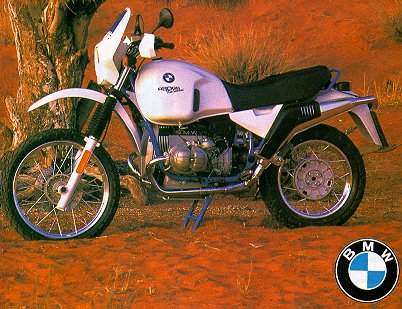


![]()